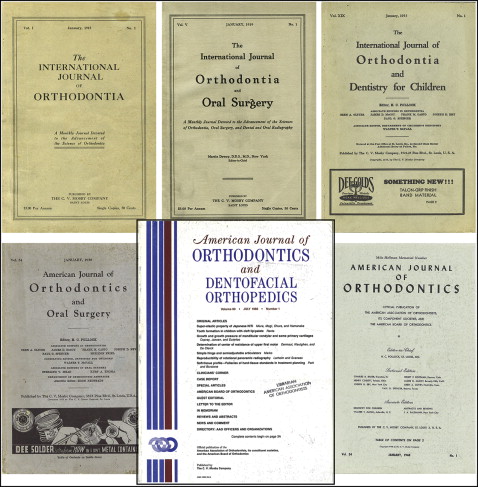
When Charles V. Mosby and Martin Dewey launched their new journal in 1915, they gave it a name that seemed to say it all: International Journal of Orthodontia . Lest there be any doubt, they added a subtitle, “A monthly journal devoted to the advancement of the science of orthodontia.” But in his inaugural editorial, Dewey gave the journal room to grow, writing that the articles published would be “on timely subjects of interest to those engaged in the practice of orthodontia, dentistry and its allied specialities.” A forward-thinking man, he also wrote that he would endeavor to “secure contributions of merit from workers in the field…regardless of ‘race, color, or previous conditions of servitude.’” An unsigned editorial in the same issue concluded that the Journal was being published “with the hope that it may benefit humanity, that it may help to increase human efficiency, and that it may become a factor in arousing interest in our child-life to such an extent that malocclusion be given as much attention as is now bestowed by school inspectors upon adenoids, eye-strain and mental defects.”
The specialty was in its infancy, and perhaps the name fit for a time, but an unsigned editorial in 1919 explained that times had changed. “In our endeavors to conduct a journal for the advancement of orthodontia, we early realized that orthodontia consists of more than mere regulating appliances, and that it would be necessary to broaden our scope in order to get articles bearing on all its phases.” To meet the changing times, a Department of Radiography was being added to the Journal , followed quickly by a Department of Oral Surgery and Surgical Orthodontia. The writer went on to note that “when the United States entered the war and the dental corps was being organized, the men in charge of the Department of Oral and Plastic Surgery at once recognized that men who had special orthodontic training made much better students in oral surgery courses.” Believing that oral surgery “at the present time is very much of an outcast,” embraced by neither medicine nor general dentistry, the editors and publisher of the Journal made what would be the first of a half-dozen name changes. It would “henceforth be known as the International Journal of Orthodontia and Oral Surgery .”
By 1933, times had changed again. Mosby wrote an editorial for the January issue in which he explained: “Since 1915 this Journal has lived to see great changes take place in dental and economic affairs. It has seen a complete change in dental education. It has seen the economic world soar to dizzy heights of prosperity and then plunge to almost unbelievable depths of economic despair. It has seen the map of Europe remade and the diadems of the Romanovs and Hohenzollerns literally cast into the dust. It has seen a complete revolution in the attitude of both the dental and the medical professions toward child life.” Editor H. C. Pollock also weighed in: “Just as medicine at last realized that a strong, healthy, virile nation depended upon healthy, properly developed children…so will dentistry in the not distant future realize that preventive dentistry starts with the child…” With that, the separate departments of oral surgery and radiography were being dropped, and the Journal was rechristened International Journal of Orthodontia and Dentistry for Children .
Within a few years, however, the pendulum had swung back. In a 1936 editorial, Mosby wrote that when the name had been changed 2 years earlier, “the editorial staff knew that it was an experiment, and the permanency of the department of dentistry for children was to depend upon its results.” Apparently the results did not live up to the editors’ hopes, and the Journal returned to its earlier name, International Journal of Orthodontia and Oral Surgery .
Pollock announced 2 changes at once in 1938. He quoted a letter that Professor Price of the Oxford Dictionary staff wrote to the Nomenclature Committee of the American Association of Orthodontists: “The term orthodontia suggests that it means a flower, a disease, or a city in Asia. Orthodontics , on the other hand, is neat in appearance, easy to pronounce, and tells you at once, more or less, what it means…The case of ics is still more simple. Since the fifteenth century, it has been used in English to denote a science.” Furthermore, the Journal wanted to emphasize its close connection to “the newly formed American Association of Orthodontists.” Therefore, the new name would be American Journal of Orthodontics and Oral Surgery . A decade later, Pollock dropped “oral surgery” from the name, and for the next 30 years, it was simply American Journal of Orthodontics .
In the mid 1970s, talk of another change emerged. B. F. Dewel wrote an editorial promoting the term dentofacial orthopedics because “it more accurately describes the actual clinical therapies that currently are being used by orthodontists everywhere.” By “everywhere,” he seemed to be casting his eyes toward Europe. He noted that the French preferred orthopédie dento-faciale , and in Germany, it was kieferorthopädie (jaw orthopedics). In 1980, editor Wayne Watson added “A journal of dentofacial orthopedics” to the title, and Tom Graber made it official in 1986: American Journal of Orthodontics and Dentofacial Orthopedics .
The Journal name has changed over the years, confounding reference writers and indexers ( Fig ). But its mission remains the same: to publish “meritorious contributions on timely subjects of interest of those engaged in the practice of orthodontia, dentistry and its allied specialities.”





